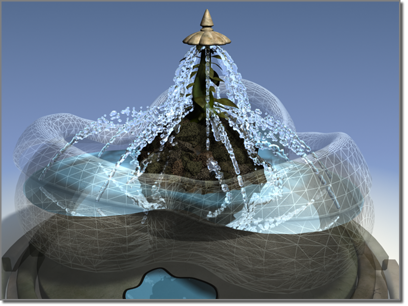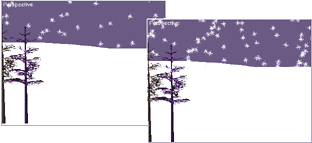Non-event-driven particle systems provide relatively simple, straightforward methods for generating particle sub-objects over time for the purpose of simulating snow, rain, dust, and so on. You use particle systems primarily in animations. 3ds Max provides six built-in, non-event-driven particle systems: Spray, Snow, Super Spray, Blizzard, PArray, and PCloud.

Fountain spray created as a particle system
Interface

Snowstorm created as a particle system
This topic describes only the general properties of particle systems. Other plug-in particle systems might be available in your configuration.
The built-in particle systems share these controls:
- Emitter
-
Specifies where in the scene the particles are generated. The emitter is the particle system's main sub-object. It doesn't render. Particles appear on the surface of the emitter and fall (or drift, drop, flurry, spray) from the emitter in a particular direction.
- Timing
-
The timing parameters control the dynamics of particles in the system. They specify how quickly particles appear, how quickly they disappear, whether the emission rate is constant, and so on.
- Particle-specific parameters
-
These parameters are specific to the kind of particle system. Examples are particle size and speed.
- Rendering properties
-
These parameters are also specific to the kind of particle system. There are options for displaying particles in viewports and rendering them in scenes and animations. Particles do not necessarily appear the same in renderings as they do in viewports.
You can modify and animate particle system parameters. You can also affect particle system behavior with space warps. In addition, you can deform particle systems with the Mesher compound object.